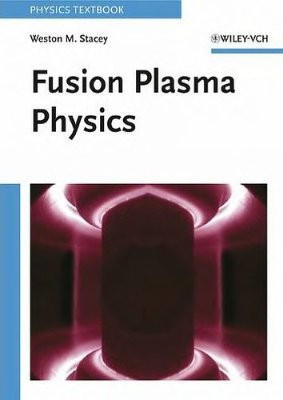Wiley-VCH, 2005, 561 pp. – ISBN 3-527-40586-0.
This book is intended as a textbook for students with little or no knowledge of plasma physics but with the background in math and physics that would be expected of the graduate of a good undergraduate physics or nuclear engineering department. Essentially all of the material can be covered in a two-semester course. The sections that are not marked with an asterisk contain material that can be covered in a one-semester course for students at the senior or first year graduate level. The sections marked with an asterisk contain material that I would omit from a one-semester course either because it is of lower priority or at a more advanced level. The book should also serve as a self-study guide for advanced students and professionals on the newer material not found in other textbooks. Since the book provides many practical computational formulas, it should further serve as a useful reference for practicing professionals, and it has a detailed index for that purpose.
Contents:
Basic Physics.
Motion of Charged Particles.
Magnetic Confinement.
Kinetic Theory.
Fluid Theory.
Plasma Equilibria.
Waves.
Instabilities.
Neoclassical Transport.
Plasma Rotation.
Turbulent Transport.
Heating and Current Drive.
Plasma-Material Interaction.
Divertors.
Plasma Edge.
Neutral Particle Transport.
Power Balance.
Operational Limits.
Fusion Reactors and Neutron Sources.
Appendices. Index.
This book is intended as a textbook for students with little or no knowledge of plasma physics but with the background in math and physics that would be expected of the graduate of a good undergraduate physics or nuclear engineering department. Essentially all of the material can be covered in a two-semester course. The sections that are not marked with an asterisk contain material that can be covered in a one-semester course for students at the senior or first year graduate level. The sections marked with an asterisk contain material that I would omit from a one-semester course either because it is of lower priority or at a more advanced level. The book should also serve as a self-study guide for advanced students and professionals on the newer material not found in other textbooks. Since the book provides many practical computational formulas, it should further serve as a useful reference for practicing professionals, and it has a detailed index for that purpose.
Contents:
Basic Physics.
Motion of Charged Particles.
Magnetic Confinement.
Kinetic Theory.
Fluid Theory.
Plasma Equilibria.
Waves.
Instabilities.
Neoclassical Transport.
Plasma Rotation.
Turbulent Transport.
Heating and Current Drive.
Plasma-Material Interaction.
Divertors.
Plasma Edge.
Neutral Particle Transport.
Power Balance.
Operational Limits.
Fusion Reactors and Neutron Sources.
Appendices. Index.

